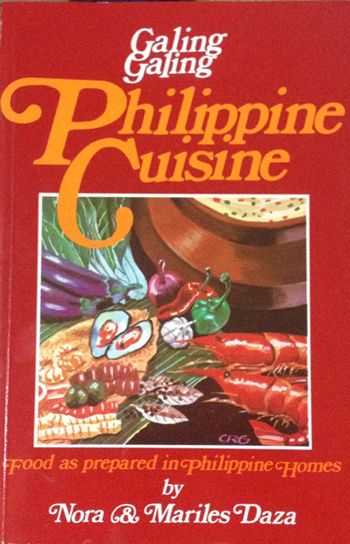SUMMARY
This is AI generated summarization, which may have errors. For context, always refer to the full article.

MANILA, Philippines – The passion for cooking is rooted in the desire to eat well. When we are hungry, we crave and look for food. Because we are given the illusion of choice, we are unable to see beyond the illusion of living in a food paradise. We are distracted by the circus of the commercial food industry and are unable to tell what we are truly hungry for or what sustenance our bodies truly need.
We are caught in this trap. We move in circles as the fate of our gastronomic lives becomes pre-determined by the economics of big business rather than values. Big budgets are thrown into marketing tried and tested food products, with a bit of repackaging here and there, to perpetuate the product’s hold over the market, generation after generation.
Our minds and palates have become trained and conditioned to subsist in what I call “non-food-food” — food made up of materials and ingredients that are not food in the traditional sense, or industrial products that have found applications in food manufacturing.
Our appetites and palates have been eroded by fad diets and pop food, food designed to appeal to our eyes rather than our palates. Food that is convenient. Food that punctuates our image with a status symbol, rather than food that makes sense, not only because it tastes better, but also because it is more nutritious for our bodies, and good for the environment and our economy.
These commercial food products are manufactured the same way every other consumer product is made. Everything is merely a product, everything is produced in large quantities and everything is manufactured with profit as the motive.
Even in restaurants these days, good food is more about branding, packaging and beautiful presentation rather than about flavor and nourishment. Few restaurants really give a premium on quality and freshness of their ingredients as almost everything served are re-heated pre-cooked commissary-supplied pre-portioned food.
Fastfood and convenience store culture
When we are hungry, we fill up, but still have a certain kind of hunger that lingers. Our system craves for nutrients, thus we feel a degree of dissatisfaction and a sickening feeling somewhere in the gut.
Modern food technology has won the battle in addressing hunger with convenience products, fast food, frozen food, chemically treated food, hormone and steroid treated food, genetically modified crops and everything else one could imagine.
These products are systematically distributed into almost every point across the country. Amid the rows of canned and packaged food in groceries and sari-sari stores, we have forgotten that food comes from the earth. Our food culture has totally been altered by instant food.
When I was growing up, the women of the family always talked about food and cooking, exchanging recipes and sharing food with neighbors in the village. I’d tag along with my mom as we visited friends’ houses for cooking lessons of sorts and have merienda afterwards.
Nora Daza and the craft of Filipino cooking
 I reflect on day when cooking at home and cooking for the family was in vogue. It’s timely as THE Nora Daza, an icon of Filipino cookery, has just passed. Her work as a cook opened a whole stream of culinary traditions that seeped into many of our households. Her books and recipes became roadmaps for new wives and mothers of the ’60s, ’70s and ’80s, as they tried to become better home cooks and raise happy and healthy families.
I reflect on day when cooking at home and cooking for the family was in vogue. It’s timely as THE Nora Daza, an icon of Filipino cookery, has just passed. Her work as a cook opened a whole stream of culinary traditions that seeped into many of our households. Her books and recipes became roadmaps for new wives and mothers of the ’60s, ’70s and ’80s, as they tried to become better home cooks and raise happy and healthy families.
READ: Nora Daza passes away at 84
I never had the chance to meet her, Nora Daza, and now I know I never will in person. But I knew who she was as every cook at home consulted her books every now and then. As a kid in the kitchen, I heard her name many times over. I partook of many great meals that took inspiration from her work, at home and at other people’s homes, during the time when families took pride in their own cooking.
Now a cook myself, I take from the same consciousness that Nora Daza’s life work emanated from. Good food prepared with the knowledge of the fundamentals of cookery, using the best and freshest ingredients. Being best doesn’t meant it is expensive, hard to find and imported.
The best ingredients are the simplest, the most natural, the most local. Getting reacquainted with cooking is a good start to winning back our lives — good cooking begins with learning about ingredients.
When we learn to cook, we unlock the mysteries of our food. We begin to ask questions about our ingredients, where they come from. We scrutinize the quality, freshness, color, smell and aroma. We learn about cooking techniques, we notice how heat changes the character of ingredients, how flavors develop.
The more we ask, the more we discover. Why is it called “fresh milk” if it was shipped from New Zealand 3 months ago? We know when santol is the sweetest, we realize real vinegar is more fruity, we discover native chicken makes tastier tinola. No greater classroom is there for a cook than a garden or a farmers’ market, where one could connect to the real source of our food.
Only in one’s continued cooking can one awaken the senses: to taste, aroma, texture, color and love. Mastering the craft takes patience and practice, but once learned, it opens a new level of consciousness that affects every part of one’s being.
Let us all cook, not because of its romance, but because it is the most sensible thing to do. It will teach us more about life than we ever expect.
Learn to cook
Cooking is not only about skill, it’s also about educating your palate.
1. Scrutinize your ingredients
Look at them, touch them, smell them, taste them. Know their individual characteristics. By doing this, you will acquaint yourself with each component and understand how to compose flavors, textures and colors in a dish. As much as possible, use fresh basic ingredients; not processed pre-seasoned components.
2. Start by cooking simple recipes with few components
Not only is it less intimidating, you get to taste basic flavors in your food, too. It will also teach you to season mindfully. Sometimes it’s just the amount of salt you use that makes the difference in flavor.
3. Cook for yourself
By cooking for yourself, you get to understand your palate better. Once you know what tastes and flavors appeal to you, it is easier to navigate through cooking since you know where you are taking a dish, from raw materials to finished product.
Once you go through the entire process, successfully or not, you are able to assess your skill level and target new lessons to learn to perfect dishes. You can now calibrate challenges and move up to better proficiency. Aside from that, you will also find yourself and your perspective.
4. Keep on cooking
Needless to say, practice makes perfect, but it needs time and patience to acquire skills and adopt a cook’s mind where cooking can be done intuitively. Gain knowledge and confidence and this will flow.
5. Cook for the right reasons
Cook because you love to cook, that is enough. Cook with all your heart and everything else will follow! – Rappler.com
Happy family cooking together photo from Shutterstock

Myke Sarthou, better known as Chef Tatung, is an entrepreneur and foodie who runs his own restaurant which specializes in artisan Filipino cooking: Chef Tatung in Acacia Estates Taguig. He is a locavore and one of Oxfam’s chef advocates for GROW, a campaign for food security in a changing climate. For comments and reactions, he can be reached through myke.sarthou@gmail.com.
Add a comment
How does this make you feel?





There are no comments yet. Add your comment to start the conversation.